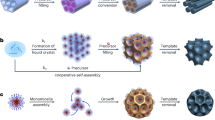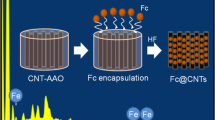Abstract
Carbon nanotubes possess unique structures and outstanding properties. However, dispersion and manipulation of carbon nanotubes in solvents severely limit their application. A solution is building carbon nanotube-based microcapsules that combine both the properties of carbon nanotubes and capsules. Carbon nanotube-based microcapsules have indeed great potential applications including catalysts, adsorbents, and controlled-release materials. Here, we built carbon nanotube-based microcapsules by electrostatic self-assembly to develop novel composite materials. The construction and morphology of microcapsules were characterized by Raman spectroscopy, infrared spectroscopy, scanning electron microscopy and transmission electron microscopy. Pre-films composed of poly(sodium 4-styrenesulfonate) and poly(diallyldimethylammoinum chloride) were assembled onto calcium carbonate (CaCO3) microparticles to construct positive solid templates. The carboxylated carbon nanotubes were then successfully assembled on the CaCO3 template using a self-assembly technique. Ethylene diamine tetraacetic acid (EDTA) was used as a powerful chelating agent to remove the CaCO3 cores by chelation between EDTA and calcium, thus completing the construction of carbon nanotube-based hollow microcapsules. The spherical shapes of the microcapsules were well retained, and the carbon nanotubes were anchored evenly in the polyelectrolyte layers.




Similar content being viewed by others
Abbreviations
- SEM:
-
Scanning electron microscopy
- TEM:
-
Transmission electron microscopy
- FTIR:
-
Fourier transform infrared spectroscopy
- PSS:
-
Poly(sodium 4-styrenesulfonate)
- PDDA:
-
Poly(diallyldimethylammoinum chloride)
- EDTA:
-
Ethylene diamine tetraacetic acid
References
Apul OG, Shao T, Zhang SJ, Karanfil T (2012) Impact of carbon nanotube morphology on phenanthrene adsorption. Environ Toxicol Chem 31:73–78
Bae J (2011) Fabrication of carbon microcapsules containing silicon nanoparticles–carbon nanotubes nanocomposite by sol–gel method for anode in lithium ion battery. J Solid State Chem 184:1749–1755
Chen W, Liu X, Liu Y, Kim H (2010) Novel synthesis of self-assembled CNT microcapsules by O/W Pickering emulsions. Mater Lett 64:2589–2592
Dasgupta K, Kar S, Venugopalan R, Bindal RC, Prabhakar S, Tewari PK, Bhattacharya S, Gupta SK, Sathiyamoorthy D (2008) Self-standing geometry of aligned carbon nanotubes with high surface area. Mater Lett 62:1989–1992
Hiller J, Mendelsohn JD, Rubber MF (2002) Reversibly erasable nanoporous anti-reflection coatings from polyelectrolyte multilayers. Nat Mater 1:59–63
Kaur A, Gupta U (2009) A review on applications of nanoparticles for the preconcentration of environmental pollutants. J Mater Chem 19:8279–8289
Liang X, Liu S, Liu H, Liu X, Jiang S (2010) Layer-by-layer self-assembled multi-walled carbon nanotubes/silica microsphere composites as stationary phase for high-performance liquid chromatography. J Sep Sci 33:3304–3312
Liu L, Zhang F, Lin X (2008) Highly sensitive biosensor based on bionanomultilayer with water-soluble multiwall carbon nanotubes for determination of phenolics. Biosens Bioelectron 24:306–312
Peng H, Jain M, Peterson DE, Zhu Y, Jia Q (2008) Composite carbon nanotube/silica fibers with improved mechanical strengths and electrical conductivities. Small 4:1964–1967
Schnorr JM, Swager TM (2011) Emerging applications of carbon nanotubes. Chem Mater 23:645–657
Wong EW, Sheehan PE, Lieber CM (1997) Nanobeam mechanics: elasticity, strength, and toughness of nanorods and nanotubes. Science 277:1971–1975
Xu H, Tan Z, Abe H, Naito M (2011) Microcapsule assembly of single-walled carbon nanotubes from spray-dried hollow microspheres. J Ceram Soc Jpn 119:180–184
Yang K, Xing B (2010) Adsorption of organic compounds by carbon nanomaterials in aqueous phase: polanyi theory and its application. Chem Rev 110:5989–6008
Yi H, Song H, Chen X (2007) Carbon nanotube capsules self-assembled by W/O emulsion technique. Langmuir 23:3199–3204
Ying LS, Salleh MABM, Yusoff HBM, Rashid SBA, Razak JBA (2011) Continuous production of carbon nanotubes—a review. J Ind Eng Chem 17:367–376
Yun J, Im JS, Lee Y, Kim H (2010) Effect of oxyfluorination on electromagnetic interference shielding behavior of MWCNT/PVA/PAAc composite microcapsules. Eur Polym J 46:900–909
Zhang L, Fang M (2010) Nanomaterials in pollution trace detection and environmental improvement. Nano Today 5:128–142
Zhang F, Wu Q, Chen ZC, Li X, Jiang XM, Lin XF (2006) Bioactive galactose-branched polyelectrolyte multilayers and microcapsules: self-assembly, characterization, and biospecific lectin adsorption. Langmuir 22:8458–8464
Zhao X, Lv L, Pan B, Zhang W, Zhang S, Zhang Q (2011) Polymer-supported nanocomposites for environmental application: a review. Chem Eng J 170:381–394
Acknowledgments
The authors gratefully acknowledge the financial support from the National Natural Sciences Foundation of China (21207125) and the Project of Zhejiang Sciences and Technology (2012C31027).
Author information
Authors and Affiliations
Corresponding author
Rights and permissions
About this article
Cite this article
Xu, L., Zhang, M. Construction of carbon nanotube-based microcapsules by self-assembly. Environ Chem Lett 12, 359–364 (2014). https://doi.org/10.1007/s10311-014-0455-5
Received:
Accepted:
Published:
Issue Date:
DOI: https://doi.org/10.1007/s10311-014-0455-5




